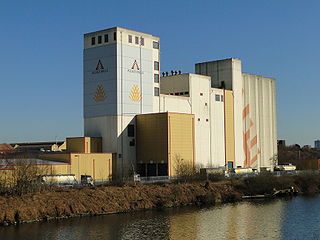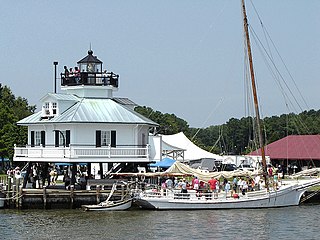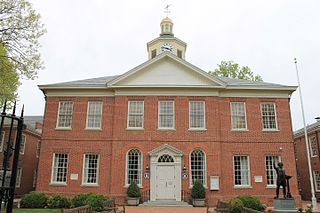
Wye Mills is an unincorporated community in Talbot County, Maryland, United States, located at an altitude of 20 feet (6.1 m). Wye Mills is located at the intersection of Maryland Route 662 and Maryland Route 404 just south of the Queen Anne's County border.

There are more than 1,500 properties and districts listed on the National Register of Historic Places in the U.S. State of Maryland. Each of the state's 23 counties and its one county-equivalent has at least 20 listings on the National Register.

The Edmee S. is a Chesapeake Bay log canoe. She was built in the Tilghman Island style from hewn logs by Oliver Duke in the 1930s. She is one of the last 22 Chesapeake Bay racing log canoes, and is actively raced with a crew of nine to eleven people. Her original name was Cecilia Mae, but was renamed for Edmee S. Combs, whose husband funded the restoration. The hull was covered with fiberglass during the restoration. She is owned by the Chesapeake Bay Maritime Museum in Saint Michaels, Maryland.

The Old Inn, also known as the Old Brick Inn, was built circa 1816 in Saint Michaels, Maryland. It is unusual for Maryland in possessing two-story porches on both its front and back sides.
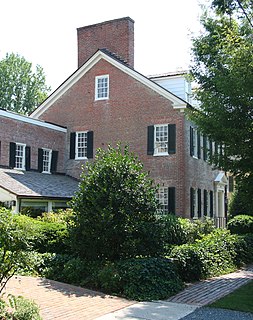
The Cannonball House in Saint Michaels, Maryland, United States, is a historic house built in the early 19th century. The Federal style house is a side-hall double-parlor design on a corner lot, built for shipbuilder William Merchant. It is historically notable for an 1813 event in the War of 1812 in which the British fleet bombarded Saint Michaels, leaving a cannonball embedded in the house.
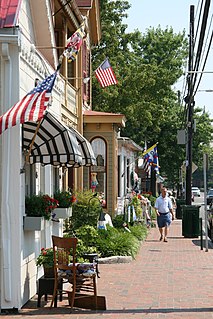
The Saint Michaels Historic District encompasses the historic center of Saint Michaels, Maryland, U.S.A. The late 18th- and early 19th-century town is a small seaport on a tributary of the Chesapeake Bay which has retained a high degree of historic integrity. Of particular interest are an unusual number of gallery-fronted houses.

Crooked Intention is a historic home in St. Michaels, Talbot County, Maryland, United States. It is a 1 1⁄2-story brick dwelling, three bays wide with wings, built about 1753. A 1 1⁄2-story Flemish bond wing was added in 1956. Also on the property is the original brick smokehouse and a beaded clapboard dairy.
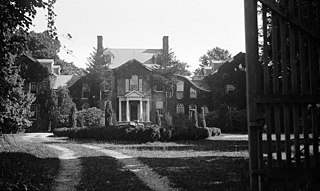
Hope House is a historic home located near Easton, Talbot County, Maryland. It is a seven-part brick mansion in which the central block is the original, Federal portion, built about 1800. The hyphens, wings, and additions were built during the first decade of the 20th century to replace earlier hyphens and wings. It was home to members of the Tilghman and Lloyd families.

The Wye Town Farm House is a historic home in Easton, Talbot County, Maryland, United States. It is of brick construction, one and one-half stories high and two rooms deep with a small one-story brick kitchen. A two-story addition was made in the 20th century. The original section of the house dates from about 1800.

Sherwood Manor, also known as Sherwood's Neck, is a historic home about four miles west of Saint Michaels, Talbot County, Maryland. It is a post-Revolutionary War brick structure located on a small point of land in Hemmersley Creek. The house is a five bay, two story brick structure, with an unusual pair of inset panels, the size of windows, on both stories of the west gable end. It was acquired in 1771 by Matthew Tilghman, a Maryland statesman and onetime member of the Continental Congress, to augment his own large property holdings in the area, which included his home at Rich Neck Manor. Matthew Tilghman's son, Lloyd Tilghman, occupied the Sherwood property and built Sherwood Manor some time before 1798.

Orem's Delight is a historic home at Bellevue, Talbot County, Maryland, United States. The house, which was built about 1725, is a 20-by-25-foot, 1 1⁄2-story brick structure with an interior chimney. It is one of the few small 18th-century structures to have survived without incorporation into a larger dwelling.

Rock Clift, or High Banks, is a historic home at Matthews, Talbot County, Maryland, United States. It is a two-story, three-bay Flemish bond brick house with dormers and has a one-story four-bay frame addition that was built in two sections. The brick house appears to date from about the 1780s.

The Wilderness, or High Banks, is a historic home at Matthews, Talbot County, Maryland, United States. It overlooks the Choptank River and was constructed in two periods. The smaller 2 1⁄2-story, four-bay-long brick structure is attributed to the 1780-90 period, and the larger portion is in Flemish bond brick and dates to around 1815. Also on the property are two early outbuildings, a smokehouse, and dairy. It was the home of Daniel Martin, the 20th Governor of Maryland.

Victorian Corn Cribs are historic agricultural buildings at St. Michael's, Talbot County, Maryland. The two structures feature elaborate tracery along the eaves and bargeboards, and are connected by a low, rough shed. They were moved from their original site on the north side of U.S. Route 13, about two miles east of Westover, in Somerset County, to their present Talbot County site in June 1975.
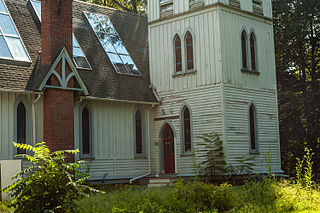
All Saints' Church is a historic Carpenter Gothic style Episcopal church at Easton, Talbot County, Maryland, United States. It is a small rectangular frame church constructed in 1900-1901. The exterior features of the church include a three-stage bell tower with a shingled spire. The interior features imported stained glass windows from Munich, Germany, along with decorative tile floors, a darkly stained exposed timber roof structure, and intricately carved church furniture. The church was designed by New York architect, Henry Martyn Congdon.
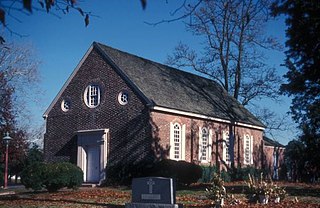
Old Wye Church is a historic Episcopal church at Wye Mills, Talbot County, Maryland. It is a one-story, gable-roofed, rectangular brick structure originally constructed in 1717–21. It was extensively renovated in 1854 and restored to its 18th-century appearance in 1947–49. It embodies the distinctive characteristics of Georgian Anglican architecture in its brick construction, semicircular-arched window openings, shouldered buttresses, rectangular plan, and simple massing.

St. John's Chapel of St. Michael's Parish is a historic Episcopal church at Easton, Talbot County, Maryland. It is a granite Gothic Revival ruin. The building measures 35 feet wide and 50 feet deep. The chapel was built in about 1835 and abandoned around 1895.

The Magic is a Chesapeake Bay log canoe, built in 1894, by Charles Tarr in St. Michaels, Maryland, She measures 34'-3 5/8" long with a beam of 6'-11". She served as a commercial oystering vessel until 1924 when she was returned to her sailing rig. After her conversion Magic proved to be one of the fastest canoes on the Bay, winning the first Governor's Cup race in 1927. She one of the last 22 surviving traditional Chesapeake Bay racing log canoes that carry on a tradition of racing on the Eastern Shore of Maryland that has existed since the 1840s. She is located at St. Michaels, Talbot County, Maryland.
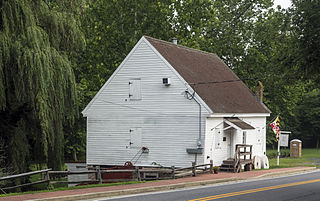
The Wye Mill is the oldest continuously operated grist mill in the United States, located at Wye Mills, Queen Anne's County and Talbot County, Maryland, United States. It is the earliest industrial site on the Eastern Shore in continuous use; dating to the late 17th century. It is a wood-frame, water-powered grist mill, with a 19th-century 26 HP 10-foot-diameter (3.0 m) Fitz steel overshot wheel. The mill retains nearly all of its late-18th-century equipment. The Wye Mill was one of the first grist mills to be automated with the Oliver Evans process, which is still in use today.

The Miller's House is a historic house on Old Wye Mills Road in Talbot County near Wye Mills, Maryland. The 2.5 story brick building was built c. 1770 by Edward Lloyd III, the owner of Wye Mill, for the miller to live in. The house as three bays, with a central door, and chimneys set in the outer walls. The house was built at a time when Talbot County's agricultural base was gradually shifting from tobacco to grain crops, and the Lloyds probably built the house to attract and retain skilled millers.

